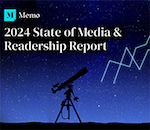 Ronn Torossian Ronn Torossian |
Americans get their information from a variety of news sources every day but, despite this, our general trust in the media remains far lower than it should be. This perceived lack of trust can be blamed on a number of factors, but what everyone agrees on is that it’s an issue. This is especially highlighted in times of great national stress, which is why the CEO of one of America’s chief media institutions says now is the time to prove the value of news.
Speaking to CNN, New York Times CEO Mark Thompson said the COVID-19 pandemic, as terrible as it has been, is an opportunity for media to reconnect with audiences that may harbor some doubts about the institution:
“Moments like this, as extraordinary and terrible an experience which this country and the world is going through, is a moment for news organizations and newspapers to find audiences and prove the value of trustworthy news …”
Other media outlets agree that working around the clock to offer the most up-to-date information about the virus and both its global and local impact are essential. And, in many cases, these outlets are doing so with drastically reduced revenues.
Almost across the board, advertising revenue for the past few months is way down. Many businesses had to close, either temporarily or permanently. Others simply chose to stop advertising because they needed to find a way to keep their doors open with dramatically reduced customer numbers. So, the resources many media outlets had to work with were reduced, but the hunger for information rose even higher.
Subscriptions at the Times, for example, jumped by about six million in the first three months of 2020, a “record” increase, according to CNN. According to Thompson, this happened while ad revenue fell by “up to 50 percent.”
Other media outlets faced similar numbers: massive demand, minimal resources. They had to find a way to soldier on. Hence, the “opportunity” Thompson spoke of. People were watching and listening and reading, desperately hoping for information that would protect their family and, possibly, save their lives.
If news outlets—large and small, local and national—are able to manage to give people clear and accurate information, they could see a turn in the national mood toward the media. There will always be those who don’t like one news outlet or another, for a host of reasons. However, if the media gives them information they need that helps them at the proverbial “kitchen table” level of their lives, then it’s likely many people will continue going back to that source for their news.
There’s a caveat to this, of course. News outlets have to get better and more effective using social media to get the word out and to promote their brand. Digital advertising and information sharing is now the primary go-to for most American consumers, and those numbers will just continue to grow as generations raised on smartphones continue to enter the economy. Traditional media must find a way to meet people where they are, rather than expecting the masses to come to them as they did when they were the only game in town.
***
Ronn Torossian is CEO of 5WPR, the 2020 American Business Awards PR agency of the year.


 Trump Media & Technology Group today reported a $58.2M net loss on $4.1M in 2023 revenues, a disclosure that drove its stock price down 22.6 percent to $47.96.
Trump Media & Technology Group today reported a $58.2M net loss on $4.1M in 2023 revenues, a disclosure that drove its stock price down 22.6 percent to $47.96. Barry Pollack, an attorney at Wall Street’s Harris St. Laurent & Wechsler, has registered Julian Assange as a client with the Justice Dept. “out of an abundance of caution.”
Barry Pollack, an attorney at Wall Street’s Harris St. Laurent & Wechsler, has registered Julian Assange as a client with the Justice Dept. “out of an abundance of caution.” Paramount Global to slash 800 jobs in what chief executive Bob Bakish calls part of an effort to “return the company to earnings growth"... Rolling Stone editor-in-chief Noah Shachtman is exiting at the end of the month due to disagreements with chief executive Gus Wenner over the direction the magazine is taking... The New York Times broke the $1 billion barrier in annual revenue from digital subscriptions in 2023... Press Forward is investing more than $500 million to strengthen local newsrooms.
Paramount Global to slash 800 jobs in what chief executive Bob Bakish calls part of an effort to “return the company to earnings growth"... Rolling Stone editor-in-chief Noah Shachtman is exiting at the end of the month due to disagreements with chief executive Gus Wenner over the direction the magazine is taking... The New York Times broke the $1 billion barrier in annual revenue from digital subscriptions in 2023... Press Forward is investing more than $500 million to strengthen local newsrooms. The majority of news articles are read within the first three days of publication, according to a recent report.
The majority of news articles are read within the first three days of publication, according to a recent report. The Los Angeles Times gives pink slips to 115 people or 20 percent of its newsroom staff... TIME is also laying off about 30 employees, which is approximately 15 percent of its editorial staff... The Baltimore Banner, which was launched by Stewart Bainum in 2022 after he failed to buy the Baltimore Sun, added 500 subscribers per day in the three days following Sinclair Broadcast Group's deal to purchase the Sun.
The Los Angeles Times gives pink slips to 115 people or 20 percent of its newsroom staff... TIME is also laying off about 30 employees, which is approximately 15 percent of its editorial staff... The Baltimore Banner, which was launched by Stewart Bainum in 2022 after he failed to buy the Baltimore Sun, added 500 subscribers per day in the three days following Sinclair Broadcast Group's deal to purchase the Sun.


 Have a comment? Send it to
Have a comment? Send it to 
No comments have been submitted for this story yet.